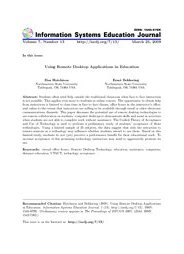Volume 7
Volume 7, Number 13 |
March 25, 2009 |
Abstract: Students often need help outside the traditional classroom when face to face interaction is not possible. This applies even more to students in online courses. The opportunity to obtain help from instructors is limited to class time in face to face classes, office hours in the instructor's office, and online to the extent that instructors are willing to be available through email or other electronic communications channels. This paper discusses the potential use of remote desktop technologies to use remote collaboration on students' computer desktops to demonstrate skills and assist in activities when students are not able to complete work without assistance. The Unified Theory of Acceptance and Use of Technology is used to perform a preliminary study of students' acceptance of these technologies. Using a limited sample of 25 subjects, the data suggest that only the attraction to remote sessions as a technology may influence whether students intend to use them. Based on this limited study, students do not (yet) perceive a performance benefit for their educational work. To increase acceptance of this promising technology, instructors may need to aggressively promote its use.
Keywords: virtual office hours, Remote Desktop Technology, education, assistance, computers, distance education, UTAUT, technology acceptance
Download this issue: ISEDJ.7(13).Hutchison.pdf (Adobe PDF, 13 pages, 971 K bytes)
Preview the contents: Hutchison.j.txt (ASCII txt, 34 K bytes)
Recommended Citation: Hutchison and Bekkering (2009). Using Remote Desktop Applications in Education. Information Systems Education Journal, 7 (13). http://isedj.org/7/13/. ISSN: 1545-679X. (A preliminary version appears in The Proceedings of ISECON 2007: §2544. ISSN: 1542-7382.)
